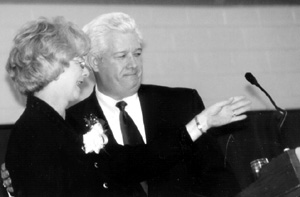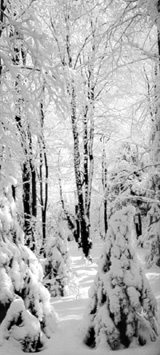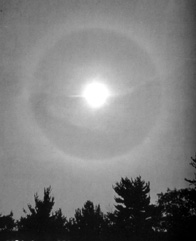
Dock of the Bay

Volume VI Number 49
December 10-16, 1998
Owens Takes Oath, Promotes 'Ideals' for Land-Use, Education
photo by Bill Lambrecht Outgoing Anne Arundel County Executive John Gary steps aside for his successor Janet Owens.
In her inaugural ceremony, Janet Owens handed golfer
John Gary the gift of a 'Big Bertha' for his bag, 26 days after clubbing
him in the race for Anne Arundel County executive.
And Gary, hours before leaving office, made Owens the gift of a mirror. "There's only one person you can absolutely 100 percent depend upon, and that's the person you see in this mirror," said the outgoing county executive.
The civil exchange opened Owens' swearing-in ceremony on a breathtakingly beautiful December 6 at Anne Arundel Community College.
The event, complete with enchanting melodies from the Severna Park High School Concert Choir and the Chesapeake Youth Symphony Orchestra, was a promising, low-key beginning. Owens, 54, a Democrat with residences in both Southern and Western Anne Arundel, is the first woman to hold Anne Arundel's highest elected office.
In her brief speech, Owens spoke simply and eloquently of Anne Arundel history and spared the 650 people in the audience hearing the sort of promises that tend to get broken. She elevated the issues that separated her and Gary - education and land-use - into principles that will guide her as county executive.
"Anne Arundel County was founded 350 years ago by our first settlers who lived in a world of pristine waters and fertile land. They held bold ideas and dreamed of the future for their children. They wanted a better way of life There was no congestion back then. There were no environmental issues. There was little crime. They were able to design their system of education as they pleased. They cared for their community," she said, in a speech that lasted just over five minutes.
"I am here to tell you that I will set a course for county government that promotes those ideals about land and education, that urges others to be dreamers and work hard to make this county the best in Maryland and that make each of us responsible for generations."
Owens went a way toward fulfilling one promise - open and accessible government - by holding her swearing-in ceremony in public and then opening the doors to her office a day later for public visits.
Democrats in the audience were as pleased by the tenor of Owens' ceremony as they were by her stunning but surprisingly easy victory over Gary Nov. 3.
"We're both delighted and astonished," said Dorothy "Dotty" Chaney, of Lothian, speaking for herself and her husband, Steuart. "It's truly like a miracle; she's the first South Countian in that office and it bodes very well for South County. She's here against the odds."
Meanwhile, Gary, who also sat in the General Assembly, departed the stage of public life, at least for now. If he glanced at that mirror he handed Owens, he might have seen clearly the single, compelling reason that he's out of work: a gruff demeanor that belied his competence as an administrator.
But as old gave way to the new in the ceremony, Gary was as charming as he could be abrasive in his past. "It's as if the weight of the world was lifted off his shoulders," observed Lisa Ritter, who was Gary's spokeswoman.
-BL
Weather Report: When Ducks
Cluster, Do Forecasters Flub?
They say if you don't like the weather around here, wait five minutes and it will change. This late autumn, it's taken longer than usual. Since Thanksgiving, we've been saying winter's just about due. But for two steady weeks, spring has hung in the air.
Answer this question: When can you remember people decorating their trees while wearing shorts?
But even as this story is being written, the unusual warmth we've both enjoyed and griped about is breaking up, according to Mark Tobin, meteorologist for the private forecasting service, AccuWeather. Any day now, the temperatures will dip back down to where they should be, and it will feel a lot more like December.
As for the rest of winter, your guess is as good as his. "A lot of this long-range forecasting is like throwing darts at a dart board," explains Tobin. The only prediction he'll chance looks forward to average temperatures with fast-moving storms that won't be dumping heaps of snow.
It says something about the nature of weather that the scientists find it a challenge, too.
If you want to know more about the science of weather, buy The National Audubon Society Field Guide to North American Weather for your gift to yourself this season. Like all the Audubon Society field guide series, it comes packaged to withstand a tornado, has lots of interesting information on causes of weather events, beautiful pictures of weather activity, cloud and ice formations, waterspouts, cyclones, land- and skyscapes and all manner of information on all things weather-related, including historical weather events, as they like to call disasters these days.
It's a beautifully done production, and well worth $18, because you will get your money's worth every time you look up a mackerel sky, a crepuscular ray or a pancake ice formation and find yourself spending 15 minutes browsing subjects like optical phenomena, flash flooding or the world-ranging effects of industrial pollution from one factory's belching smokestacks.
Weather is just too rich for science alone.
If you ask a waterman or a farmer what's going to happen tomorrow, you'll
probably get a fair assessment based on a lifetime of experience and observation.
Long before there was a United States Weather Service or an AccuWeather, people predicted the weather by observing the sky and water and by examining a whole other host of natural events. Some of these predictions are rooted, as they say, in science. Animals, for instance, can sense coming earthquakes long before humans and do act in accordingly strange manners. A ring around the moon is often an indicator of coming precipitation. In times of drought, as we've found out this summer and fall, all signs of rain do fail.
Other predictions are founded in folklore.
It's impossible to live in Chesapeake Country and not collect a portfolio of weather omens. For instance, every boater knows the rhyme red sky at night, sailor's delight/ red sky at morning, sailor take warning. And I doubt anyone reading this has not studied the woolly caterpillar's thick 'coat' or lack of it to determine the harshness of a coming winter.
In spite of the influence of television and an increasingly homogenized culture, an undercurrent of folklore, passed down from the beginning of time, still survives, sometimes with tongue firmly in cheek, other times as gospel truth. While I can't presume to comment on the accuracy of any of these nuggets of winter weather wisdom, I pass them on for your contemplation.
Winter's severity can be predicted by examining the breastbone of a Canada goose killed in the fall. A thin, fragile breastbone indicates a mild winter; a thick, sturdy bone a hard, cold season to come. A white bone dictates a lot of snow to come, a red bone severe cold. Also, close-veined goose feathers predict a hard winter.
My neighbor, Miss Estelle, says when a fruit tree's lower limbs bear more than its upper branches, it's a sign of a hard winter to come, and vice versa.
Is any of this - science or saying - accurate? We'll just have to watch and see.
-Helen Chappell with Mark Burns
In Virginia, the U.S. EPA says the state failed to include many polluted waterways - among them Chesapeake Bay tributaries - that should have been put on a list to the federal government this year. There might be a reason: Once a body of water goes on that list, the state must prepare a plan for reducing the pollution. Virginia officials say they had another reason for being selective. Once a river gets on the list, it makes it harder for 'voluntary' clean-ups ...
In Pickerington, Ohio, singles' ads are trying to match up "new agers, environmentalists, vegetarians and animal-rights activists looking for romance," the Columbus Dispatch reports. One lonely man describes himself as a "caring vegetarian attorney." A woman says she's a "bizarre cross between Gloria Steinem and June Cleaver" ...
In California, speakers have a new menace: the Biotic Baking Brigade. The chancellor of a University of California campus was the latest target when a brigade member tossed a banana cream pie in his face. The group says it will present desserts to more "foes of the environment" ...
Our Creature Feature this week comes from Florida, which is plagued by an outbreak you may not have heard about: wild pigs. It's not that they haven't been around for awhile: they were introduced by explorer Hernando DeSoto in 1539.
But in recent years, the wild pig population has expanded exponentially because they have few natural predators. By some estimates, there may be one million wild pigs gamboling and snorting in Florida's outbreak. Wildlife officials have begun to allow selective trapping and hunting to thin the population.
What's the danger? They are scarring Florida's sensitive lands and out-muscling wildlife for food. National Park Service biologist Kimj Delozier put it this way: "A pig is a pig is a pig, and you'd better believe they eat a lot of anything."
| Back to Archives |
Volume VI Number 49
December 10-16, 1998
New Bay Times
| Homepage |